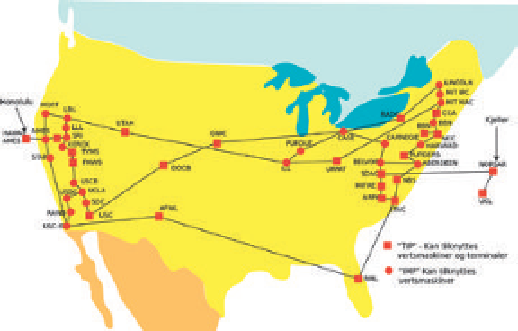Information Technology Reference
In-Depth Information
Fig. 10.15. The ARPANET topology in
September 1973 including links to
London and Hawaii.
Crowther and the theoretician Kahn had debated the problem, and pragma-
tism had won out. Now that the first four nodes were up and working, Heart
gave permission for Kahn to fly out to UCLA with Dave Walden to test his the-
ories. Kahn's first experiment demonstrated that the problem was real within
only a few minutes of sending out specific patterns of packets. He later said, “I
think we did it in the first twelve packets. The whole thing came to a grinding
halt.”
26
As a result of Kahn's results, BBN had to redesign the control system so
that enough space was always reserved in the IMP memory buffers for reassem-
bly of incoming packets. Under the redesign, the sending IMP would check that
there was sufficient space and, if necessary, delay sending the next message.
Email: The ARPANET's killer app
Bob Taylor had proposed the ARPANET to provide interactive access to
ARPA-funded computers across the United States and save money for ARPA
by sharing resources. Larry Roberts believes that both of Taylor's goals were
achieved:
By 1973, I had cut our computer budget to 30 percent of what it would have
been if I hadn't had the network. And saved more money than the network
cost. Because I could share computers all across the world and not have to buy
computers for every research group that wanted one.
27
Although it is clear that the ARPANET did enable some sharing of resources,
such cooperation was not its primary use. As Licklider and Taylor had pointed
out in their paper on “The Computer as a Communication Device,” one of the
primary uses of a network would be for communication. A 1973 ARPA report
showed that three-quarters of all traffic on the network was for what it called
“E-mail,” or more commonly nowadays called
email
. Time-sharing computers
had had email systems linking users of the same computer for some time. BBN
engineer Ray Tomlinson realized that he could extend this idea to send emails
between different computers using the ARPANET (
B.10.14
):
B.10.14. Ray Tomlinson was an
engineer at BBN who had devel-
oped some early email systems for
time-sharing computers. When he
thought about extending this idea
to messages across the ARPANET, he
needed a way to separate the name
of the recipient in the email address
from the machine the recipient was
using. He chose the @ sign.
Once we had the ability to transfer a file from one machine to the other, it
became fairly clear that one thing you could do was just write the file across
the network and send mail to somebody else. I also happened to be working


Search WWH ::

Custom Search